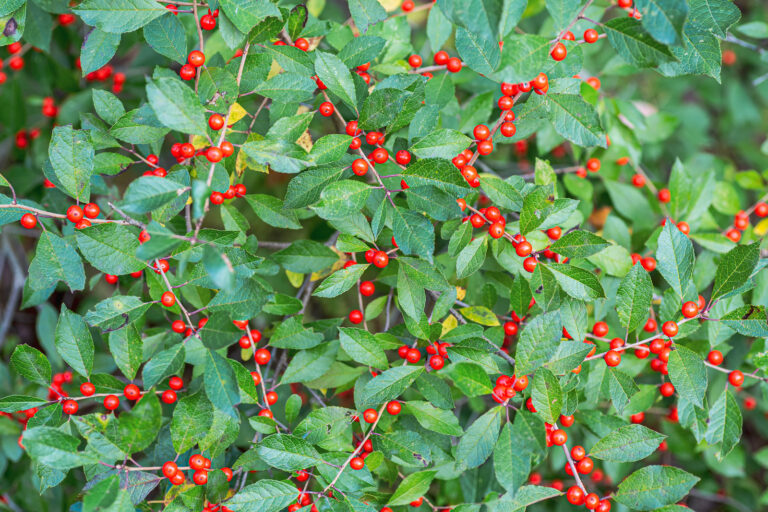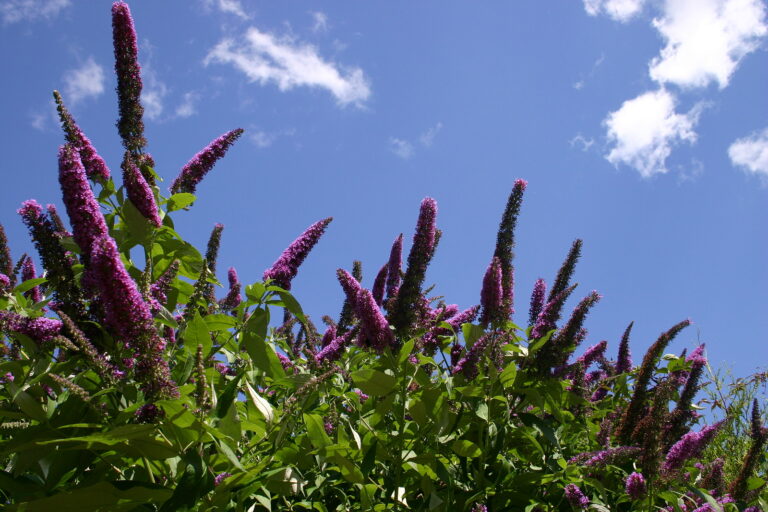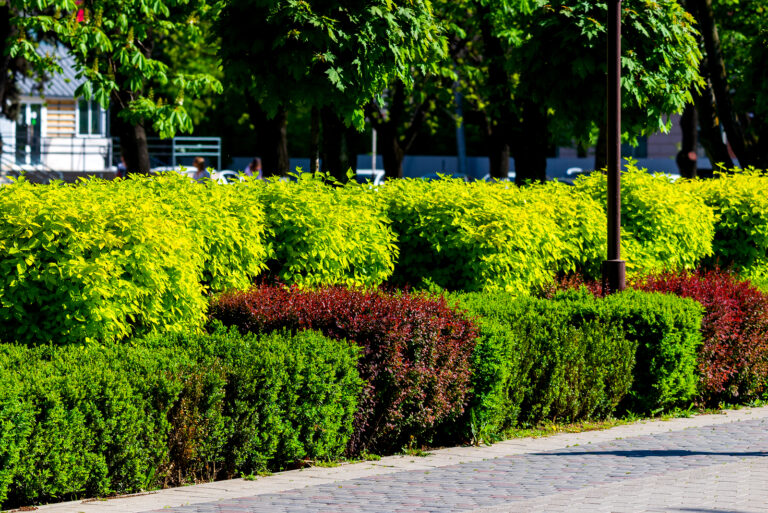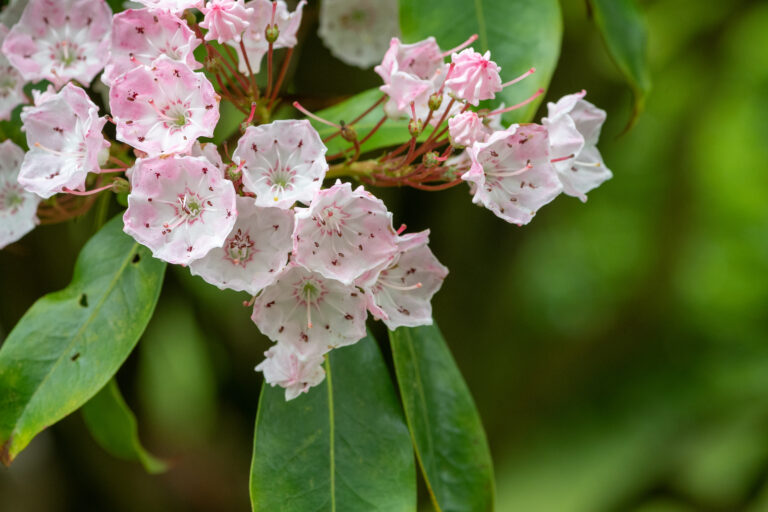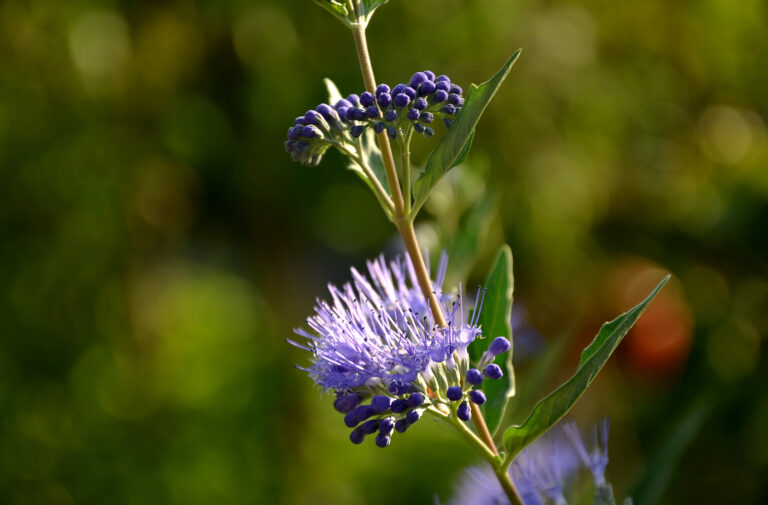How to Grow and Care for Fuchsia
Fuchsias are tender shrubs and small trees that bear showy, often pendulous flowers either singly or in clusters. Fuchsia blooms come predominately in shades of pink, purple, and cream, and many bear multicolored blooms.
The Fuchsia genus contains about 100 species and literally thousands of hybridized cultivars. Fuchsia are perennials in their native regions of Central and South America as well as New Zealand and Tahiti, but they are commonly grown as annuals or greenhouse pot plants in temperate regions of the world.
There are so many fuchsia cultivars that it is difficult to generalize, but here are the main types of fuchsia you are likely to encounter–some of these categories overlap:
- Trailing types that are well suited for growing in containers and hanging baskets.
- Bushy types can be grown in borders or as focal point specimens; some of these can be grown as hedging or trained as standards (trees-like).
- Low-growing types that do not grow to more than 20 inches (50cm) tall.
- Large types can grow to more than 6.5 feet (2m) tall.
- Hardy types will survive outdoors all year round.
- Half-hardy types are generally used as summer bedding or greenhouse and conservatory plants; they must be overwintered in a frost-free environment.
See the list of varieties to grow below for more on these types of fuchsias and a few suggested species or cultivars. Hybrid Fuchsias are most popular with home gardeners; most species are grown by Fuschia collectors with the exception, perhaps, of Fuchsia magellanica which is the hardiest species and is often grown in landscapes.
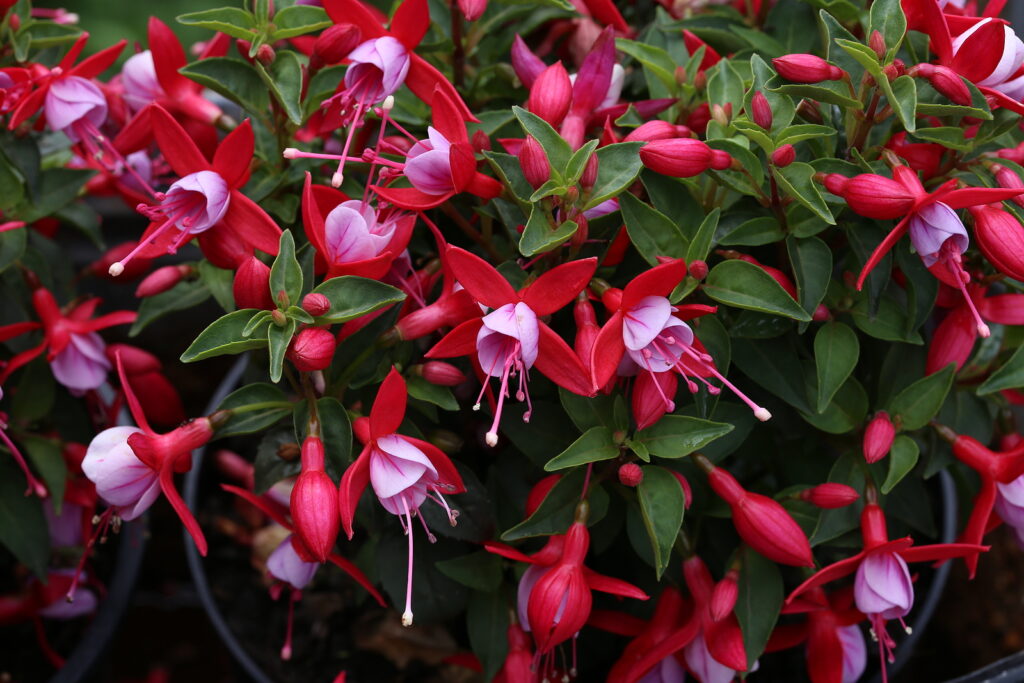
Get to know Fuschia
- Plant type: Evergreen and deciduous shrubs
- Growing Zones and range: 8-10
- Hardiness: Grow as an annual in Zones 2-8; grow as a perennial in Zones 9-11; top growth is normally killed back in cold regions
- Height and width: 6 to 36 inches (15-91cm) tall or taller depending on the variety and growing conditions
- Foliage: Green leaves are opposite or whorled, lance-shaped to broadly ovate from 1/4 inch to 10 inches (25cm) long, frequently toothed.
- Flowers: Axillary and usually pendulous flower in terminal clusters with short to long perianth tubes, each topped by colorful sepals and four broad petals forming a cup or bell; flower size can vary from very small .5-2ch across to large 2.5 inches (6cm) across; flower colors in pinks, purples, reds, cream, and white; some are bicolor
- Bloom time: Spring through frost
- Uses: Border plants or containers and hanging baskets in Zones 8-10
- Common name: Fuchsia, lady’s eardrops
- Botanical name: Fuchsia species and hybrids
- Family: Onagraceae
- Origin: Mountainous regions of Central and South America and New Zealand
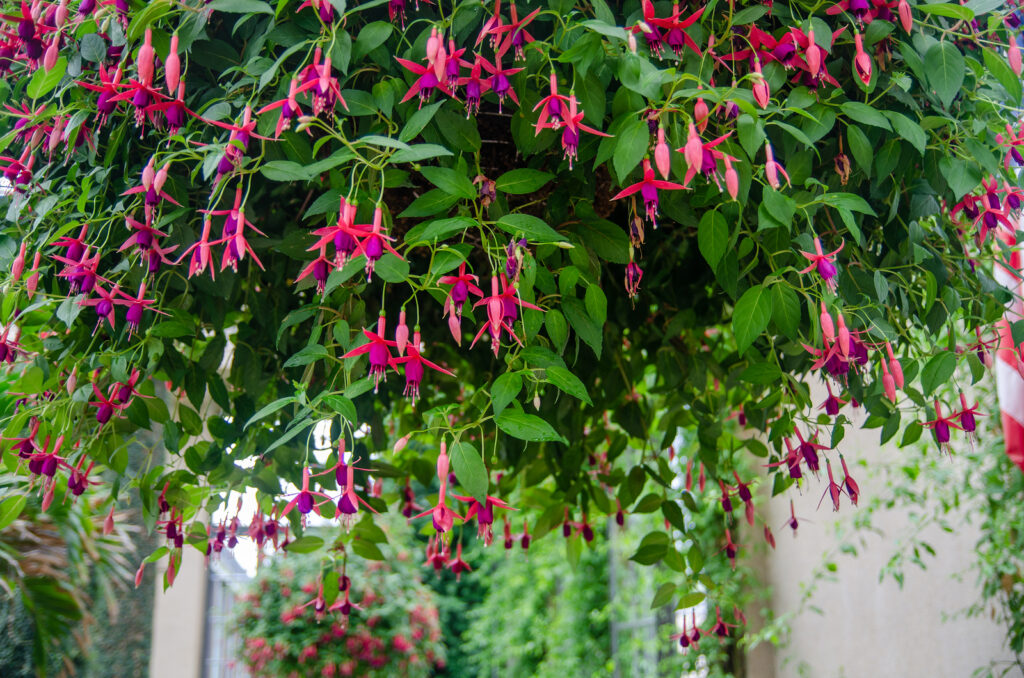
Where to plant Fuchsia
- Plant fuchsia in the morning sun and afternoon shade in warm, hot regions; plant in full sun in cool summer regions.
- Grow fuchsia in average, neutral to acidic, well-drained soil; humus-rich, well-drained soil is best.
- Fuchsia prefers a soil pH of 6.0 to 7.0.
When to plant Fuchsia
- Set out established fuchsias in spring.
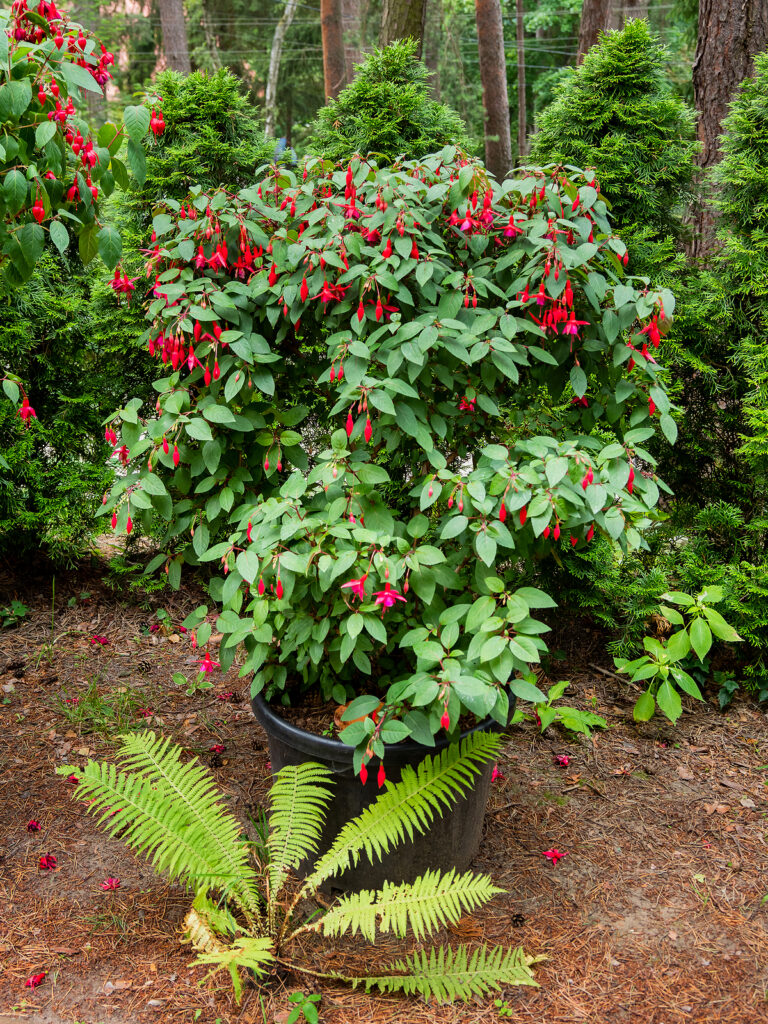
Planting and spacing Fuchsia
- Space fuchsia 18 to 36 inches (45-91cm) apart depending on the variety.
- Indoors grow fuchsia in soil-based potting mix or soilless potting mix in bright filtered with moderate humidity and good ventilation.
- Plant the base of the stem 2 inches (5cm) below the soil surface.
How to water and feed Fuchsia
- Keep the soil evenly moist; do not let the soil dry out.
- Fertilize fuchsias with a balanced liquid fertilizer every 2 to 3 weeks.

Fuchsia care
- Mulch around fuchsias to conserve soil moisture.
- Pinch off spent blooms to promote more flowering.
- Stake tall plants.
Growing Fuchsia as a houseplant
- Fuchsia x hybrida can be grown as a houseplant. They are a good choice for hanging baskets.
- Grow fuchsia in a cool room with limited light and average to high humidity.
- The growing medium should be rich and well-drained.
- Keep the medium evenly moist from spring through fall; in winter, allow the medium to dry slightly before watering.
- Plants benefit from being placed outdoors in a shaded spot during the summer.
- After a plant has flowered, cur the branches back to encourage new and compost growth, and pinch the growing tips regularly to encourage compactness.
Fuchsia pests and diseases
- Fuchsias are susceptible to mites, spider mites, whiteflies, aphids, thrips, scale insects, and root-knot nematodes can attack fuchsias.
- Rust, gray mold, crown gall, crown, root rots, Southern blight, and Verticillium wilt can occur.
Fuchsia propagation
- Sow seed at 59° to 75°F (15°-24°C) in spring.
- Root softwood cuttings in spring, or semi-ripe cuttings in late summer with bottom heat.
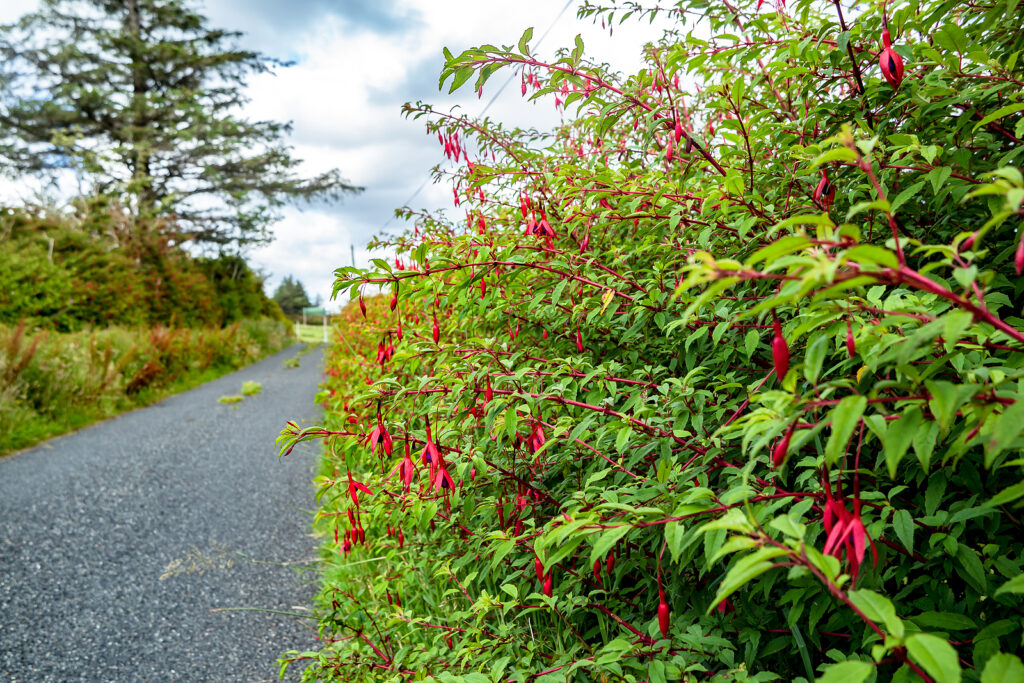
Fuchsia varieties to grow
Hardy Species and Varieties
The following fuchsias will survive winters in Zone 9 and warmer if they are in well-drained soil and a protected site:
- Fuchsia magellanica: deep crimson sepals, purple petals, and protruding stamens; bushy mid-green leaved plants can reach 10 feet (3m) tall and 20 inches (50cm) wide in mild winter region; flowers about 3/4 inch (2cm) across; cultivars include gracilis ‘Aurea’ and ‘Variegata’.
- F. ‘Riccartonii’ is similar to the above species with grey-green leaves.
Hardy hybrids
These are erect, bushy hybrids with larger flowers and a wider color range than the hardy species.
- ‘Abbe Farges’ bears small semi-double flowers with cherry-red sepals and rosy lilac petals;; 30 inches (75cm) tall.
- ‘Alice Hoffman’ bears small semi-double flowers with pink sepals and white petals; 30 inches (75cm) tall.
- ‘Eva Boerg’ bears pink-white sepals with purplish-pink petals; 30 inches (75cm) tall.
- ‘Garden News’ bears large double flowers with pink sepals; can be trained as a standard.
- ‘Lady Thumb’ bears semi-double flowers with white petals showing pale pink veins; grows to 24 inches (61cm) tall.
- ‘Lena’ bears semi-double flowers with pale pink sepals and purple petals; grows to 24 inches (61cm) tall.
- ‘Madame Cornelissen” bears semi-double flowers with deep crimson sepals and white petals; grows to 4 feet (1.2m) tall.
- ‘Margaret’ bears crimson sepals and scarlet-streaked, bluish-purple petals; grows to 4 feet (1.2m) tall.
- ‘Margaret Brown’ has pink sepals and petals; grows to 26 inches (65cm) tall.
- ‘Mrs. Popple’ bears scarlet sepals and rich purple flowers; grows to 4 feet (1.2m) tall.
- ‘Rufus’ bears dark red sepals and dark red petals; grows to be 20 inches (50cm) tall.
- ‘Snowcap’ bears semi-double flowers with red sepals and white petals with pink veins; can be trained as a standard.
- ‘Tennessee Waltz’ bears double flowers with rose petals and mauve petals; can be trained as a standard.
Half-hardy species
These are mainly grown in large pots or planted in beds as annuals.
- F. x. bacillaris bears tiny pink to red flowers; grow to 6.5 feet (2m) tall.
- F. denticulata (syn. F, serratifolia) long tubular flowers with red sepals and bright orange petals; grows to 6.5 feet (2m) tall.
- F. mirophylla bears small purple-red flowers; grows to 2 feet (61cm) tall.
- F. procumbens bears pale orange flowers; grows to 4 inches (10cm) tall.
Half-hardy hybrids
The most popular group of Fuchsias with large flowers. Usually not hardy enough to grow outdoors year-round. In this list, triphylla hybrids have very short sepals and very long tubes; they are sometimes called clustered fuchsia.
- ‘Billy Green’: triphylla type; deep pink flowers.
- ‘Cascade’: trailing type; long flowers with white sepals and flushed pink and backward curving petals.
- ‘Checkerboard’: erect bushy plant; dark red petals with white upward curving sepals; can be trained as a standard.
- ‘Coachman’: erect bushy plant; salmon-pink sepals with orange petals; can be trained as a standard.
- ‘Coralle’: triphylla type; orange flowers.
- ‘Dancing Flame’: erect bushy plant; double-flowered with orange sepals and carmine petals.
- ‘Florabelle’: trailing type; small red-purple and purple semi-double flowers.
- ‘Gartenmeister Bonstedt: triphylla type; deep orange flowers, bronze-red leaves.
- ‘Golden Marinka’: trailing type; red sepals and deep red petals.
- ‘Heidi Ann’: erect bushy plant; double flowers with crimson sepals and lilac-pink petals.
- ‘Mantilla’: triphylla type; crimson flowers with a purple hue.
- ‘Mary’: triphylla type; scarlet flowers, bronze-purple leaves.
- ‘Nellie Nuttall’: erect bushy plant; crimson sepals with white petals.
- ‘Pink Galore’: trailing type; double flowers with pin sepals and pale rose-pink petals.
- ‘Pink Marshmallow: trailing type with double flowers with white sepals and white petals.
- ‘Red Spider’: trailing type with long flowers, crimson sepals, and red petals.
- ‘Royal Velvet’: erect bushy plant; double flowers with crimson sepals and rich purple petals; can be trained as a standard.
- ‘Swingtime’: erect bushy plant; double flowers with deep red sepals and white petals.
- Thalia’: triphylla type; orange-red flowers, red to bronze leaves.
- ‘Trumpeter’: triphylla type; pink flowers, blue-green leaves.
Fuchsia frequently asked questions
Q: How can fuchsia be grown as houseplants?
A: Fuchsia are easily grown as houseplants but if the temperature stays warm year-round they will not bloom. Fuchsia will suffer if the temperature exceeds 70°F. In winter, keep the temperature at 50° to 60°F. You must overwinter the plant in a cool room. Flowers are borne on new growth, so cut back the stems in early spring just before growth begins.
Q: What fuchsias will bloom indoors in winter?
A: Magellan Fuchsia is a winter bloomer (most fuchsias rest in winter). It is an almost vinelike variety and will look good in a hanging basket or on the shelf where it can flow over the edges. The small flowers are ruby red. Most fuchsias are summer bloomers. Be sure the soil stays just moist, not too wet or too dry. Give the plant full light but not full sun, rich soil, and plenty of humidity—mist often. The botanical name of this plant is Fuchsia magellanica grailis.
Q: Do fuchsias need a rest period or can they be kept blooming the year around?
A: Fuchsias are not ever-blooming. Almost all fuchsias rest in winter. They should be kept dry and cool until early spring. Let them rest in a cool cellar or room and water very little. In early spring, cut them back (they bloom on new growth) and give them warmer quarters. Water more as new shoots appear. Don’t plant fuchsias outside until all danger of frost is past.
Q: What is the cause of buds and blossoms falling off a fuchsia plant on a window shelf indoors?
A: Too hot and or too dry an atmosphere will cause fuchsia buds and blooms to drop. Roots too wet or too dry can also cause bud and bloom to drop. Root injury causes leaf drop.
Q: What is a good way to protect indoor fuchsias from spider mites and pests?
A: Daily misting of growing fuchsias are a good deterrent to pests.


